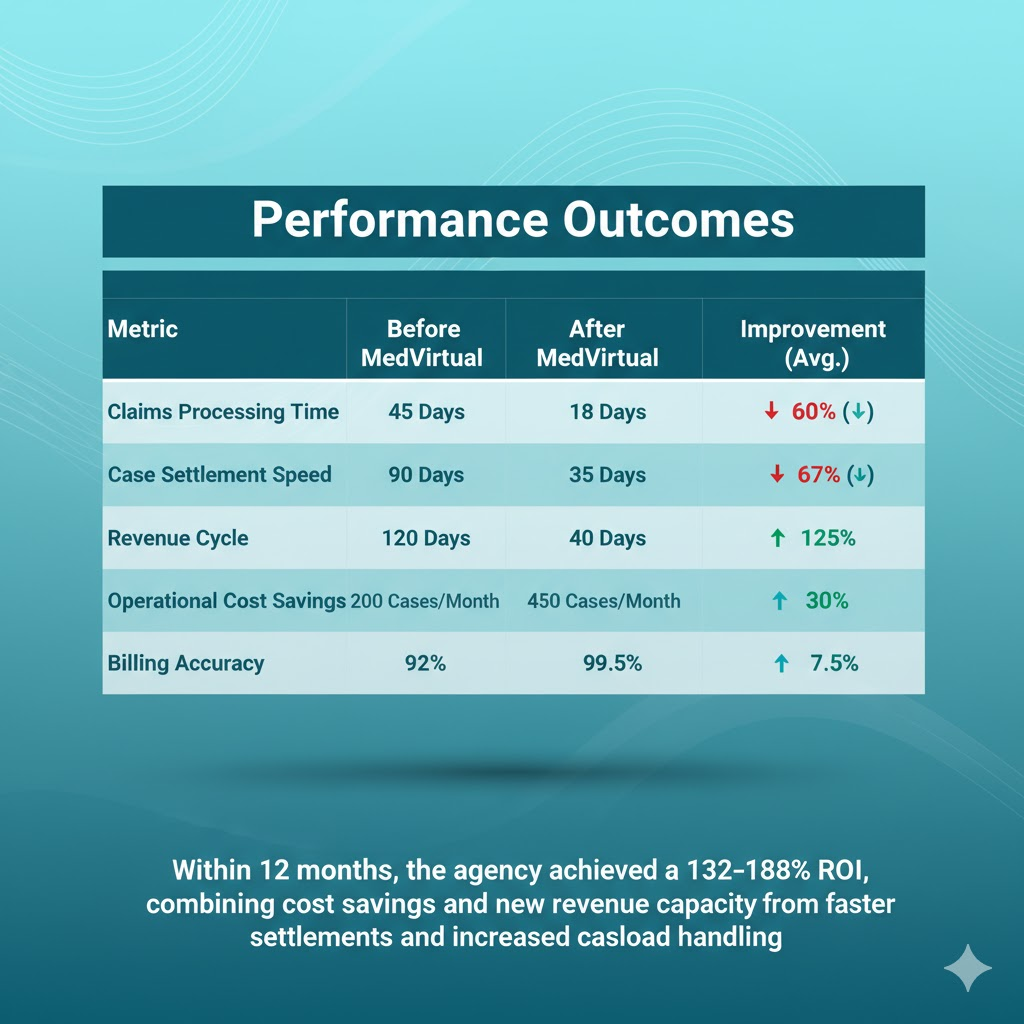Many med-legal agencies reach a point where operational success begins to strain internal capacity. Rising case volumes, compliance requirements, and administrative workloads create persistent bottlenecks that limit scalability.
A Colorado-based personal injury support agency experienced this challenge firsthand. Established in 2007, the firm had built a strong reputation with consistent case inflow and experienced personnel. Yet, their traditional staffing model could not keep pace with demand.
Fragmented systems, including HAL CRM, RingCentral, and a network of spreadsheets, created disjointed workflows. Intake forms sat in one system, medical record requests in another, and key follow-ups frequently slipped through the cracks. The agency faced an ongoing backlog that delayed settlements and strained client satisfaction.
Hiring additional in-house staff would have required 10–15 new employees, representing an annual cost of $400K—$500K in salaries and benefits, an unsustainable solution in a competitive labor market.
Instead, the agency adopted a virtual staffing model through MedVirtual, and the results redefined their operational capacity.
Key Operational Challenges Identified
Before implementation, three core bottlenecks limited performance:
- Delayed Client Intake Response
Intake callbacks averaged two to three days, resulting in a 30% client attrition rate as prospects moved to other firms. The existing CRM lacked visibility, forcing the intake coordinator to manage priorities through personal spreadsheets. - Inconsistent Data Management
Provider names, notes, and case details were entered inconsistently, making accurate reporting impossible. Without clean data, leadership could not see pending medical records or case timelines. - Rigid Staffing Capacity
Case volume fluctuated dramatically, 80 new cases in one month, 40 the next. Traditional staffing created costly inefficiencies during low-volume periods and insufficient support during surges.
Why Virtual Staffing Became the Strategic Choice
The agency’s managing partner initially viewed virtual staffing with caution. Concerns centered on data security, HIPAA compliance, and potential quality gaps. However, when evaluating cost structures and scalability, the math was straightforward:
- Traditional hiring: $400K–$500K annually (plus recruitment, training, and turnover risk)
- Virtual staffing: $200K–$250K annually, with trained med-legal specialists and quality oversight
The choice wasn’t about replacing employees but creating operational leverage.
The MedVirtual Implementation Framework
MedVirtual’s virtual staffing model focuses on three structured phases to build stability, quality, and scalability in med-legal operations.
Phase 1: Stabilize – Establish Reliable Workflow Control (Weeks 1–4)
The priority was consistency and accountability. MedVirtual introduced:
- Service Level Agreements (SLAs) ensure same-day callbacks and 24-hour follow-ups on provider requests.
- A Traffic Light Queue System that visually tracked every open task (red = overdue, yellow = approaching deadline, green = on track).
- Virtual assistants trained specifically in med-legal processes, HAL CRM, and HIPAA compliance.
Daily syncs and transparent activity logs built trust between on-site and virtual teams. Same-day callback rates improved from 50% to 87% within the first month.
Phase 2: Tighten – Enforce Data Integrity (Weeks 5–12)
MedVirtual implemented “forced consistency” rules within the CRM:
- Required data fields for each case stage
- Standardized naming conventions for providers and facilities
- Weekly 10% quality audits by supervisors
The result was immediate. By week eight, leadership could generate accurate reports on pending medical records, something previously impossible. Data errors dropped by 68%, transforming reporting accuracy and management visibility.
Phase 3: Rhythm – Achieve Scalable Capacity (Weeks 13+)
Once workflows stabilized, MedVirtual enabled flexible scaling through a pool of cross-trained virtual assistants.
When case volume surged 40% in March, three additional VAs were onboarded within 72 hours. When volume declined in July, the team scaled down seamlessly, avoiding layoffs and overhead costs.
A significant innovation was the introduction of Playcards, standardized, step-by-step operational guides for each core workflow. These ensured seamless handoffs and knowledge continuity, even when team members changed.
Result: The agency sustained a 40% increase in case volume over six months without adding permanent staff.

Implementation Lessons
- Reframe Virtual Staffing as Enablement, Not Replacement
Early resistance from in-house employees shifted once roles were clarified: virtual staff managed high-volume administrative work, while on-site teams focused on client relationships and strategy. - Accept Imperfect Integration
API limitations in HAL CRM delayed automation, but temporary manual workarounds sustained progress. Perfection is less important than momentum. - Transparency Builds Trust
Real-time dashboards, activity tracking, and consistent communication ensured accountability and eliminated skepticism about remote productivity.
Is Virtual Staffing the Right Fit for Your Agency?
Virtual staffing is ideal for med-legal organizations that:
- Manage repetitive, high-volume administrative workflows
- Experience seasonal or cyclical case volumes
- Struggle to recruit HIPAA-compliant local staff
- Need greater visibility and process consistency across teams
It may be less suited for agencies with unstructured, ad-hoc processes or without secure digital infrastructure.
Building a Scalable Med-Legal Operation
Operational efficiency is no longer optional for med-legal agencies competing in a high-volume, compliance-driven environment. Traditional hiring models cannot adapt to fluctuating demand and rising labor costs.
MedVirtual’s structured virtual staffing model demonstrates that scalability, compliance, and cost efficiency coexist, empowering agencies to process cases faster, reduce backlog, and focus on strategic growth.

Ready to Explore Scalable Virtual Staffing for Your Med-Legal Agency?
Learn how MedVirtual’s specialized approach can help your firm reduce costs, improve workflow reliability, and scale confidently.
Frequently Asked Questions
1. Are MedVirtual's virtual staff HIPAA compliant?
Yes. All MedVirtual specialists are rigorously trained and certified in HIPAA, HITECH, and PHI protocols. We operate under a mandatory Business Associate Agreement (BAA) with your agency, legally committing us to the same security standards as your covered entity. Our staff uses secure, encrypted communication channels and verified access controls.
2. Where are your virtual assistants located?
MedVirtual provides US-based management and oversight with a global sourcing model. Our staff is strategically located and trained to align with US business hours, data security laws, and specialized med-legal workflows.
3. How do you ensure the security of my sensitive case files (PHI)?
We enforce strict technological and physical security measures, including:
- Use of encrypted VPNs to access your systems.
- Activity monitoring and transparent logs to track all access.
- Protocols for using secure, password-protected practice management software.
- Our virtual assistants operate from secure, dedicated workspaces.
4. What specific administrative tasks can a virtual assistant handle for a Med-Legal Agency?
Our med-legal specialists are trained to handle the entire administrative life cycle of a case, including:
- Client Intake & Onboarding: Same-day callbacks, screening, and new case setup.
- Medical Record Retrieval: Drafting requests, tracking status, and consistent provider follow-up (as highlighted in the "Delayed Client Intake Response" section).
- Data Management: Accurate entry of provider and case notes into systems like HAL CRM.
- Case Coordination: Managing scheduling, deadlines, and the Traffic Light Queue System mentioned in Phase 1.
5. Do the virtual assistants know how to use our existing software (e.g., HAL CRM, RingCentral)?
Yes. Our specialists are proficient in leading legal and medical management tools, including common CRMs and VOIP systems. Crucially, we develop and enforce Playcards (standardized workflow guides, as mentioned in Phase 3) to ensure they integrate seamlessly into your agency's specific system, regardless of its API limitations.
6. We have high and low volume months. Can MedVirtual staff scale up and down quickly?
Yes, this is a core strategic benefit. Our model is designed for flexibility. As demonstrated in the case study, we can seamlessly onboard cross-trained VAs (often within 72 hours) to manage case surges and scale down during slower periods, allowing your agency to avoid the high costs and risks associated with hiring and laying off permanent in-house staff.
7. How do I track my virtual assistant's work and productivity?
Transparency is built into our framework. We provide real-time activity logs, daily sync-ups, and transparent dashboards. In Phase 2, we implement quality audits and forced consistency rules to ensure you always have visibility into task throughput, data integrity, and compliance adherence.
8. How much does MedVirtual staffing cost compared to a traditional hire?
On average, our virtual staffing model typically costs 50-60% less than the total cost of hiring a comparable in-house med-legal specialist. This is because you avoid the expenses of:
- Salaries, benefits, and payroll taxes.
- Recruitment and training overhead.
- Office space and equipment.
9. What is the typical ROI for a Med-Legal Agency using MedVirtual?
As shown in the case study, a high-performing agency can achieve a significant return by combining cost savings with new revenue capacity. The featured agency achieved a 132–188% ROI within 12 months through:
- Cost Avoidance: $150K–$250K annually in staffing costs.
- Increased Throughput: Faster client intake and reduced backlog led to quicker settlements and a 30% boost in weekly task completion.




